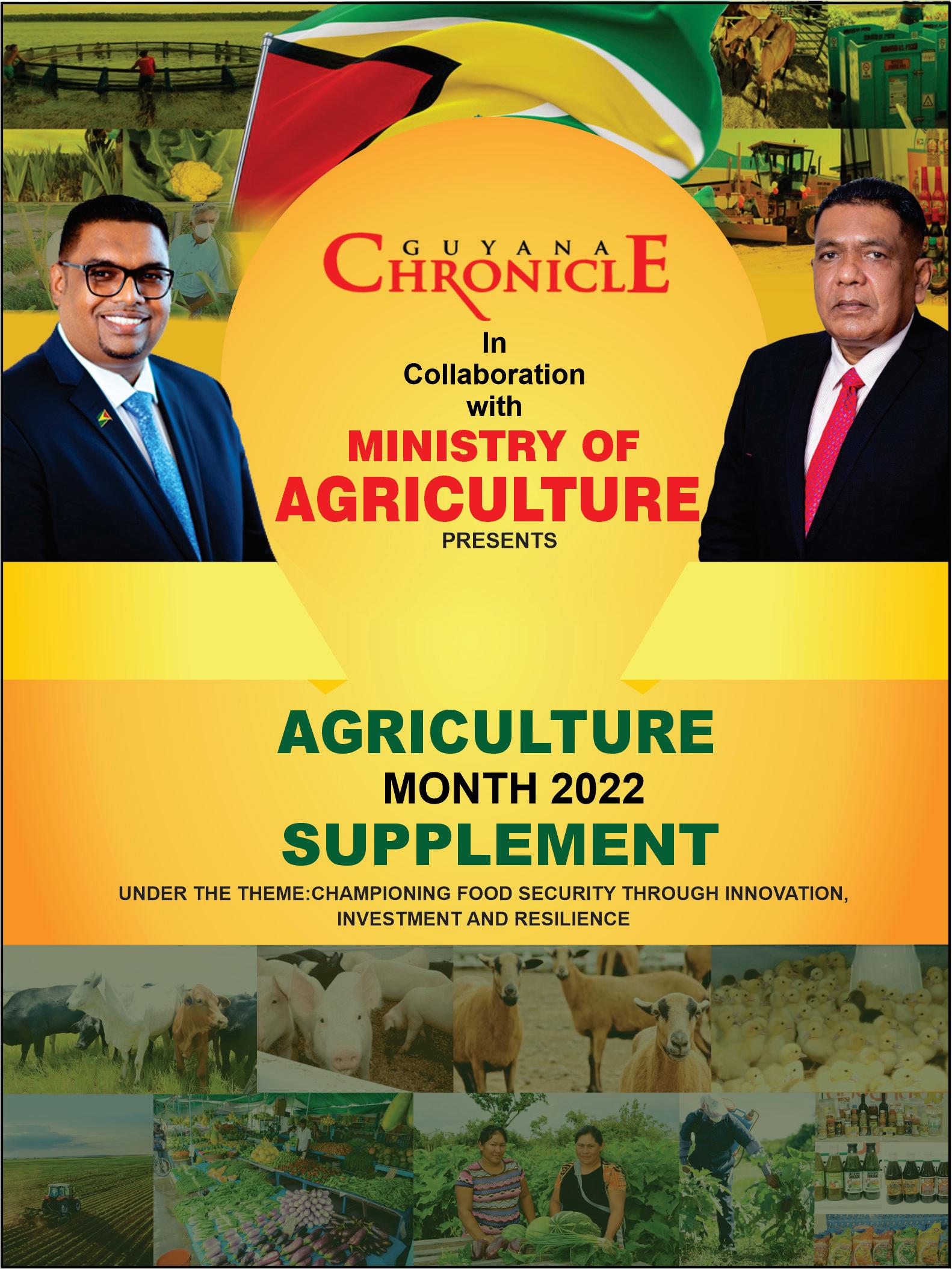

Rice farming much easier today
By Cindy ParkinsonAS the celebration of Agri culture Month continues, the Guyana Chronicle turns its focus to the Essequibo Coast, Region Two, which is a hub for bustling economic activities.
Essequibo and Esse quibians are known for their large-scale production of rice, which is distributed through out the Caribbean, Venezuela, the Netherlands and other countries around the world.
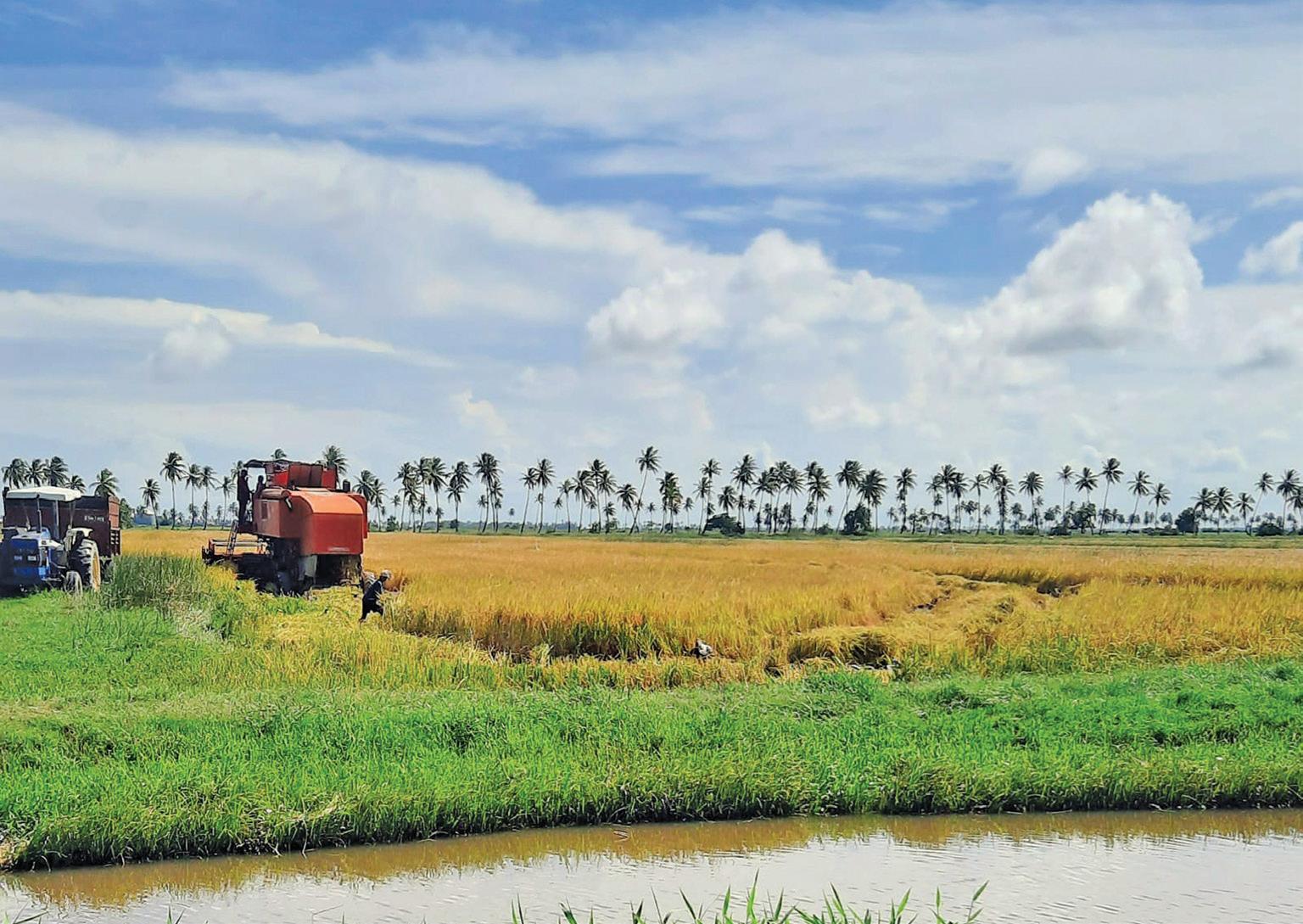
Hailing from the village of Riverstown on the Esse quibo Coast, Lionel Maesh, 51, and his sister Leelawat tie Singh, 48, grew up in a household with both of their
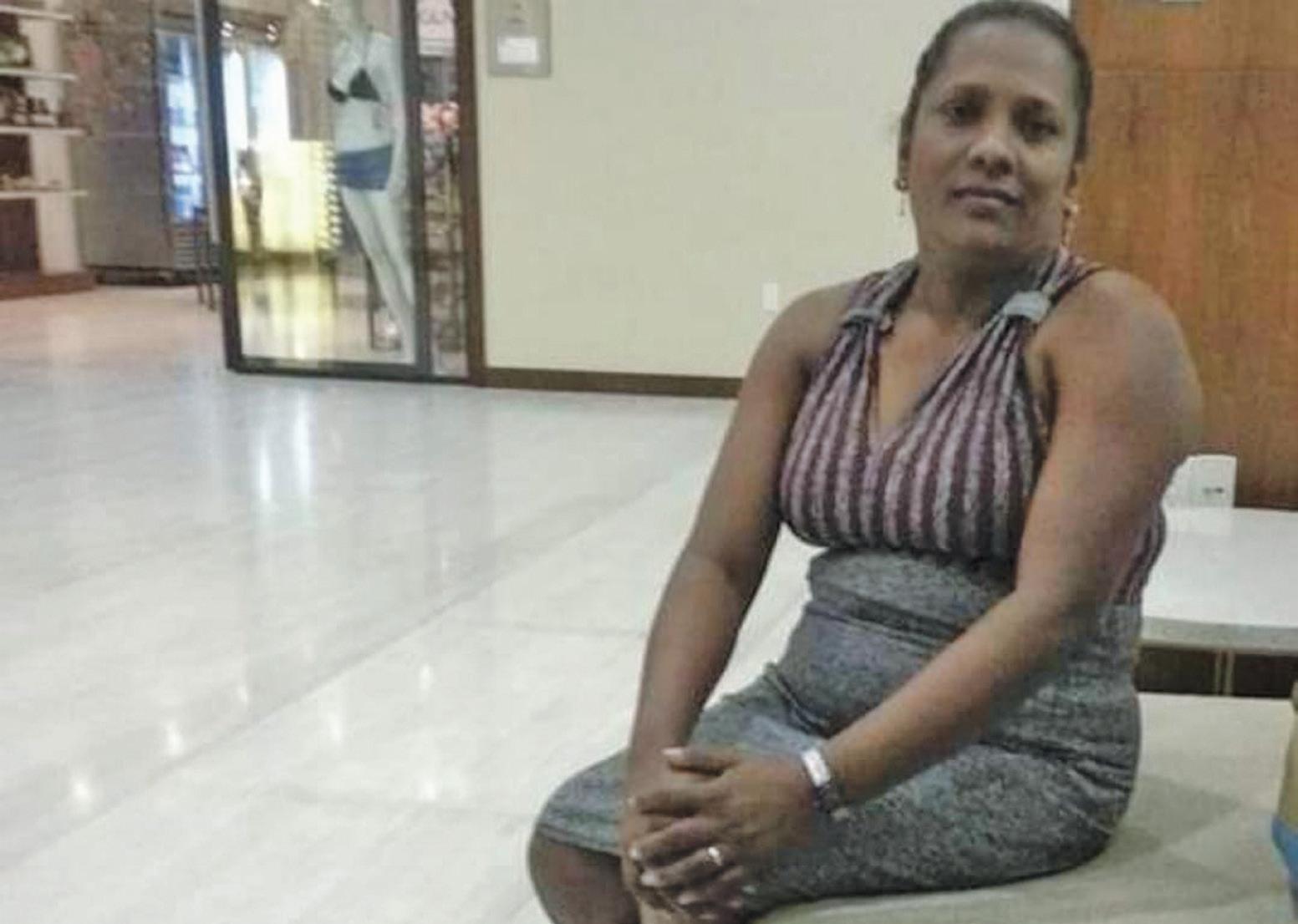

parents being rice farmers.
However, their father, Doodnauth, passed away while Maesh and Leelawattie were very young, leaving their mother, Chandroutie, to take charge of the rice fields and to feed her two children.
Growing up without their father was challenging for them, but their mother, Chan droutie, ensured that she cultivated the rice lands while playing the roles of both mother and father in their lives. Mrs. Singh explained that “both boys and girls in our days worked and helped their parents either in the rice fields, with the cattle, poultry, or in the kitchen garden at home while still having to go
to school”.
She also noted that rice farming for her and her broth er in those days was “very different” in respect to the tilling of the land, dispersion of seedlings and harvesting and transporting the paddy to the rice mills.
“In our days with my mother, we used to attach a wooden plough to the bulls as we guided them through the acres of land until the soil was upturned. The seedlings were planted by hand and if there were bugs on the plants, my brother would mix pesti cides in a bucket of water and go through the fields, using brushes to spread the mixture over the plants because we
couldn’t afford a spray can at the time. Harvesting was done by hand using a grass knife, and the bundles were lifted onto our heads to be taken to the shed that was erected at the head of the rice fields. We also used buckets to fill the bags with the pad dy, took it home on bull carts and spread it on the corner of the road to dry. After the paddy was completely dried, we re-filled the bags and took them to the rice mill on the same bull carts.”
Leelawattie explained that, in those days, it was not only different but it was “very hard work”, but nev ertheless, they had to do it in order to sustain themselves.
— back in the days it was ‘very hard work’, recall siblings in the business
With the advance of tech nology in machinery, Maesh does not have to work as much as he used to.
“Today there are tractors with ploughs and back blades that are attached to upturn the soil. We have machines to distribute the seedlings, machines to spray for bugs, combines for harvesting the rice and machines to even get rid of the weeds. There are special places for drying the paddy also. It is not done on the roadside anymore and we have trucks and tractors to transport the paddy to the rice mills,” said Maesh. He went on to say that life as a rice farmer was not as diffi cult as it once was, which is
wonderful.
Prior to the introduction of machinery, most women supported their husbands in the rice fields, much like Maesh’s wife, Lesha, did. However, they now play a crucial role in making sure that their husbands’ food is prepared for the backdam and that they are welcomed home with love and compassion. Maesh declared, “It’s difficult but rewarding work.”
On behalf of the Region Two rice farmers, Leel awattie and Maesh also expressed gratitude to the Government of Guyana for its support of fertiliser and agriculture in general.
Increasing production, reducing cost
Guyana leading efforts to reduce region’s food import bill by 2025
WITH the potential to build economies and cultivate socio- economic develop ment, agriculture is one of the most lucrative sectors in the Caribbean Community (CARICOM).
The sector provides op portunities in areas such as employment, wealth cre ation and food and nutrition security. It also increases economic activity through primary production, import substitution, manufacturing, agro-processing, intra-re gional trade, digitalisation and e-commerce.
However, the region is challenged with reducing a hefty food import bill by 25 per cent by 2025.
According to statistics provided by CARICOM, for the period 2018-2020, the region’s food import bill was US$13.76 billion, with close to US$5 billion being spent each year.
To achieve its goal, the region has undertaken vari
ous strategies, some of which target the private sector and international donor partners, with key focus being given to the areas of policy interven tion, institutional strengthen ing, investment, and sector financing.
Leading the regional ef fort is Guyana’s President, Dr. Irfaan Ali, who holds responsibility for agricultural diversification and food secu rity. He has already outlined an action-oriented and solu tion-based proposal, aimed at reducing the region’s food import bill by 25 per cent by 2025.
At the 33rd Inter-Session al Meeting of the Conference of Heads of Government of CARICOM, President Ali, in his presentation, addressed each country’s report of cur rent and target commodities to achieve the 25 per cent reduction goal, detailing both constraints and the actions that are required.
He highlighted that cof fee, cocoa, coconut, spices, hemp (industrial) and palm oil are high-value imports for CARICOM with potential for development in the region.
He said that production is expected to increase between 25 per cent and 700 per cent if food imports are going to be significantly reduced by 2025. To achieve this, nation al expenditure on agriculture must be increased.
On average, CARICOM member states expended an estimated 2.1 per cent of national expenditure on ag riculture.
However, President Ali implored that a significant in crease of about five per cent expenditure in agriculture by 2025 is required for each member state.
Guyana, he said, is com mitted to expending 10 per cent of the national budget on agriculture by 2025.
President Ali also re ported that there has been
concrete progress in access to financing for agriculture investment, through a facil ity called the CARICOM Sustainability Agriculture Credit Facility (the “Credit Facility”), using Republic Bank Limited as a lender.
This is a special facili ty designed for agriculture activities including, but not limited to, development of priority crops, capital equip ment for farming, feeder roads to provide access to arable lands, bulk storage for crops, processing plants and shade house farming.
This provides funding for up to five years for repay ment of up to G$2 billion for Guyana and US$100 million for all CARICOM member states, with interest rates as low as 2.5 per cent.
In a recent interview with the Caribbean Media Cor poration-DIME Network in Paramaribo, Suriname, on the sidelines of the 43rd Regular Meeting of the Conference
of Heads of Government of CARICOM, President Ali reported that there has been significant progress in terms of achieving the 2025 target.
ADDRESSING THE CHALLENGES
He said that an overarch ing strategy that incorporated all the stakeholders, includ ing farmers, the private sec tor, women and youth within the region was developed.
The strategy outlines spe cific actions that are required by each State in achieving the 25 by 2025 goal.
An integral part of the plan is transportation and logistics.
According to President Ali, at the CARICOM meet ing, great strides were made in developing the architecture to bring the transportation plan into action.
There was also a com mitment to advance the work to secure financing to opera
tionalise the plans as quickly as possible.
Another important as pect is removing the barriers within the region itself. The Guyanese Head of State said, “There is a clear commit ment from all the leaders that the time for discussing and talking about these bar riers is over, and we are now working on a strategic time – bound approach, and the removal of these barriers.”
Additionally, several ag riculture fora where policy makers and stakeholders in teracted were held.
The first forum, the in augural Agri-Investment Forum and Expo was held in May of this year at the Arthur Chung Conference Centre (ACCC), followed by the Agrofest at the Queen’s Park in Barbados and the second Agri Invest ment Forum and Expo in Trinidad and Tobago.
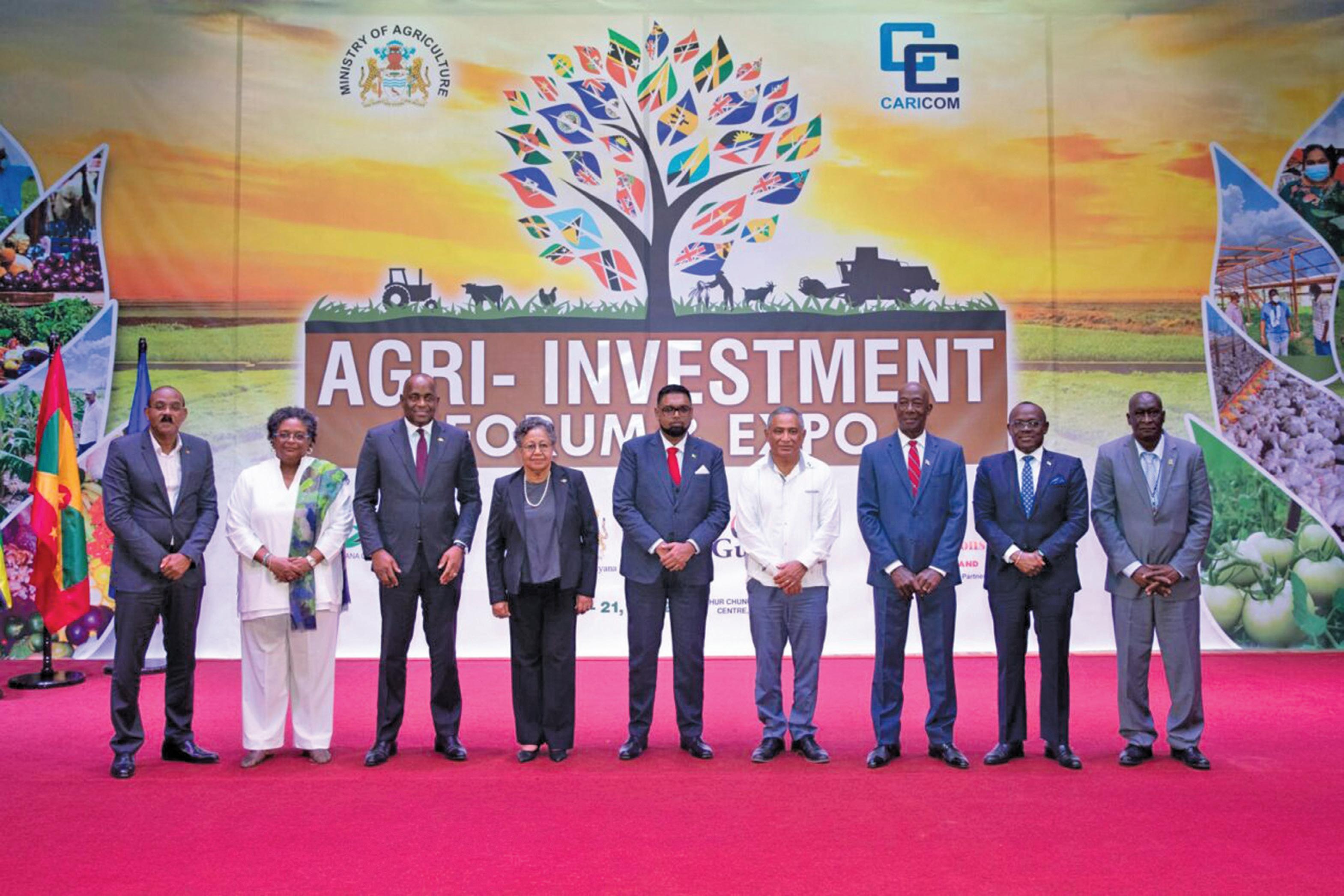
Bright future ahead for
By Cindy ParkinsonDESPITE the fact that Guyana’s coconut industry is flourishing, the current output is not enough to sat isfy consumer demand. The Guyana Government de clared at the Agri-investment earlier this year that it intends to introduce new, superior coconut types to extend the genetic base of coconuts and increase production.
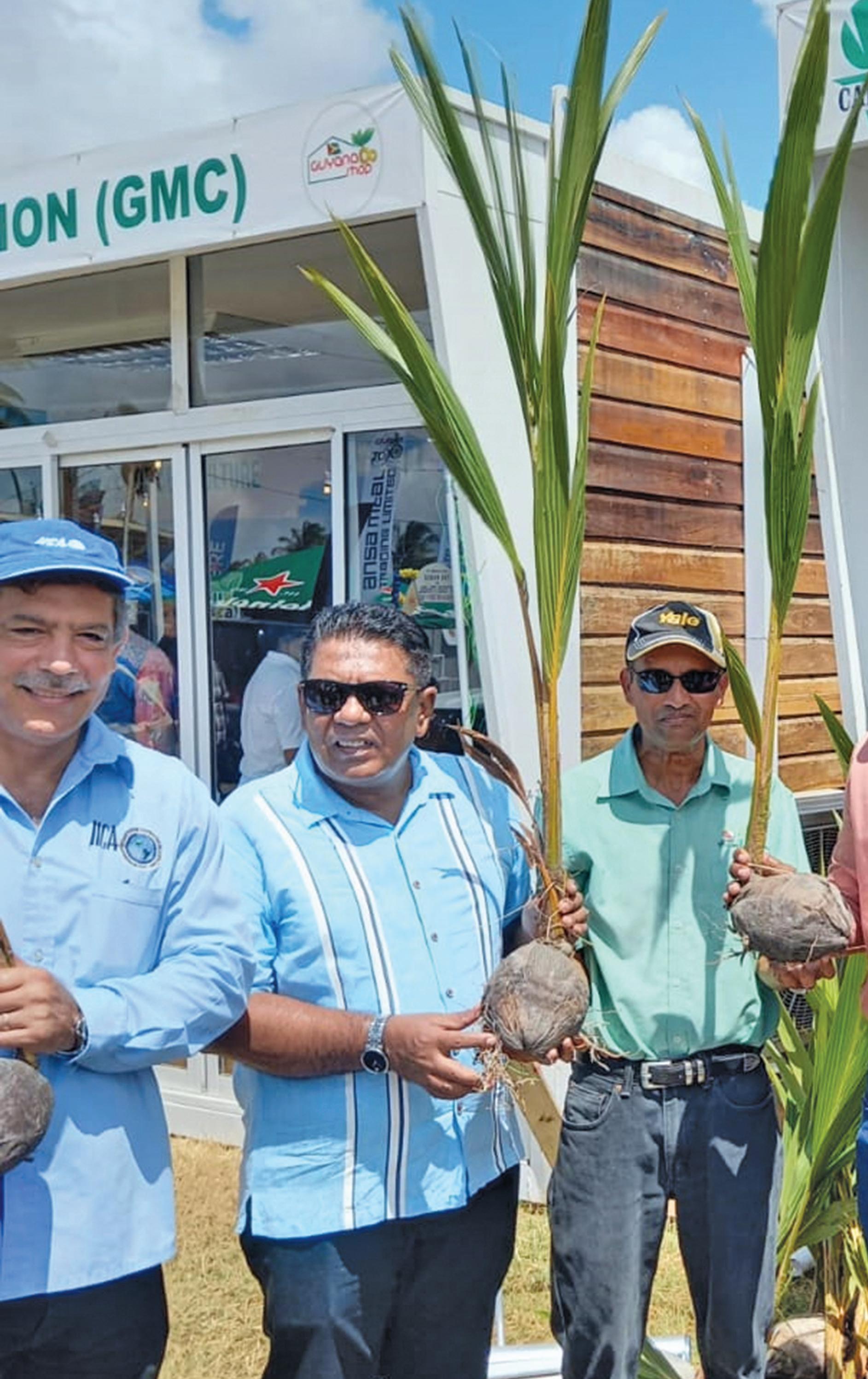
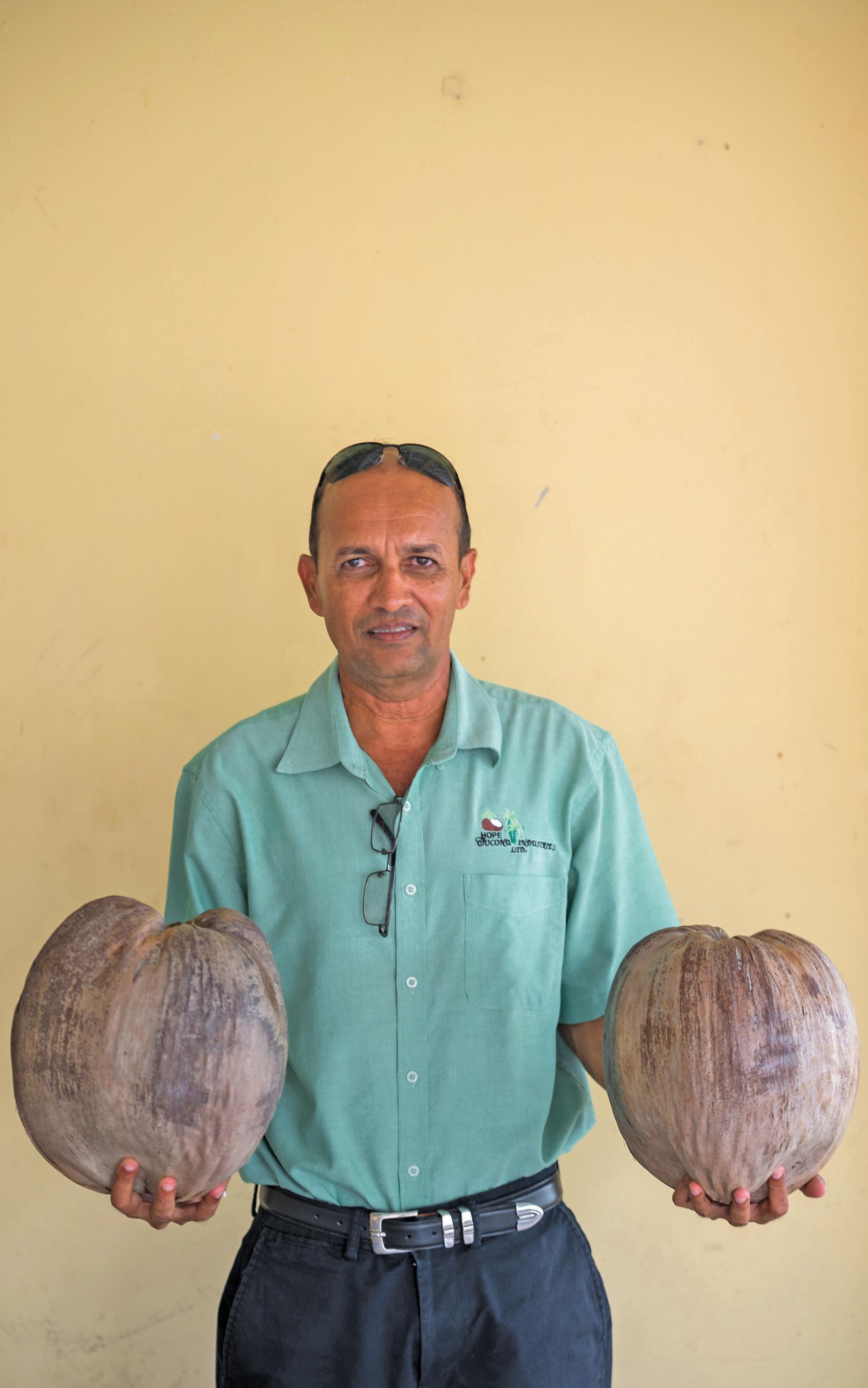
In order to support the Caribbean Agricultural Re search and Development Institute (CARDI) as part of the Regional Coconut Project
funded by the EU/CARIFO RUM, local officials organ ised and took part in a tour to the Brazil-based Coconut Seed Nut Farm of Tecnologia Na Produção De Coqueiros (Technology in Coconut Pro duction) (COHIBRA).
The main objectives were to determine whether importing 1,000 Brazilian Green Dwarf seed nuts into Guyana was feasible and to examine COHIBRA’s pro duction procedure to make sure it adhered to Guyana’s plant quarantine regulations. The coconut project’s stra tegic goal is to increase the availability of high-quality planting material in the area.
Speaking with the Guy ana Chronicle, Ricky Roop chand, General Manager of Hope Coconut Industries Limited, explained that a coconut variety usually takes a period of five to 15 years to develop. The Green Dwarf coconut that will be imported from Brazil is a high-yield ing three-year variety that took 15 years to develop. According to Roopchand, “it wouldn’t make sense to spend that amount of time, so we will have to pay the price for the neglect and import new varieties.” The Brazilian variety is the first step.
Due to the high cost of the seed nuts, Roopchand related
that only 2,000 have been paid for thus far through the government-to-government arrangements between Guy ana and Brazil. The Carib bean Agricultural Research and Development Institute (CARDI) has already paid to import the first 1,000 and approval was given, through the Ministry of Agriculture, to the Agriculture Sector Development Unit (ASDU) programme, which is funded by the Inter-American De velopment Bank (IDB), to import the other set.
GREAT OPTIMISM
The testing and observa tions of the 2,000 nuts will
be done at NAREI and Hope Coconut Industries Limited, after which special plots will be established through out Guyana, Roopchand explained. He added that there are over 2,000 coconut farmers in Guyana presently and they have shown an interest in the new variety with great optimism. With the high demand for this va riety of coconut, Roopchand is hopeful that the funds will become available so that they can import a container that will accommodate at least 14,000 seed nuts, which will give all farmers access to the variety. He also noted that they have had a sensitisation
programme in many regions so that farmers are aware of their plans going forward. This is only the beginning of this initiative, and it will be continued over the years, said Roopchand.
The company that is pro viding the seeds is COHI BRA, which is a research facility located in Fortaleza, Brazil. They are specialised in the production of geneti cally superior coconut culti vars and coconut pollen—the latter primarily used in their hybridisation programme.
To date, COHIBRA has sup plied two million seeds and coconut seedlings for both hybrids and dwarves to the
for coconut industry
local and international mar kets.
It was also noted that the three-year-old Brazilian Green Dwarf coconut is a superior variety, that is, it has a water volume of approxi mately 750 milliliters (ml). It is also ideal for oil and copra, compared to Guyana’s tra ditional variety (Malaysian Dwarf), which has a water content of 350-500 ml and to a lesser extent can be used for copra and oil, but it is not as suitable for that purpose.
In addition to Brazil, the government of Guyana is looking at other countries that have suitable varieties that can grow in Guyana.
Some such countries are Mexico and Asia.
FIRM IN DIRECTIVES
Roopchand said the Min ister of Agriculture, Zulfikar Mustapha, is very “firm” in his directives with regards to having “a very vibrant breeding programme” which will be established shortly.
According to him, a “coco nut unit” has already been established at the National Agriculture Research and Extension Institute (NAREI), which is the prime research institution in Guyana.
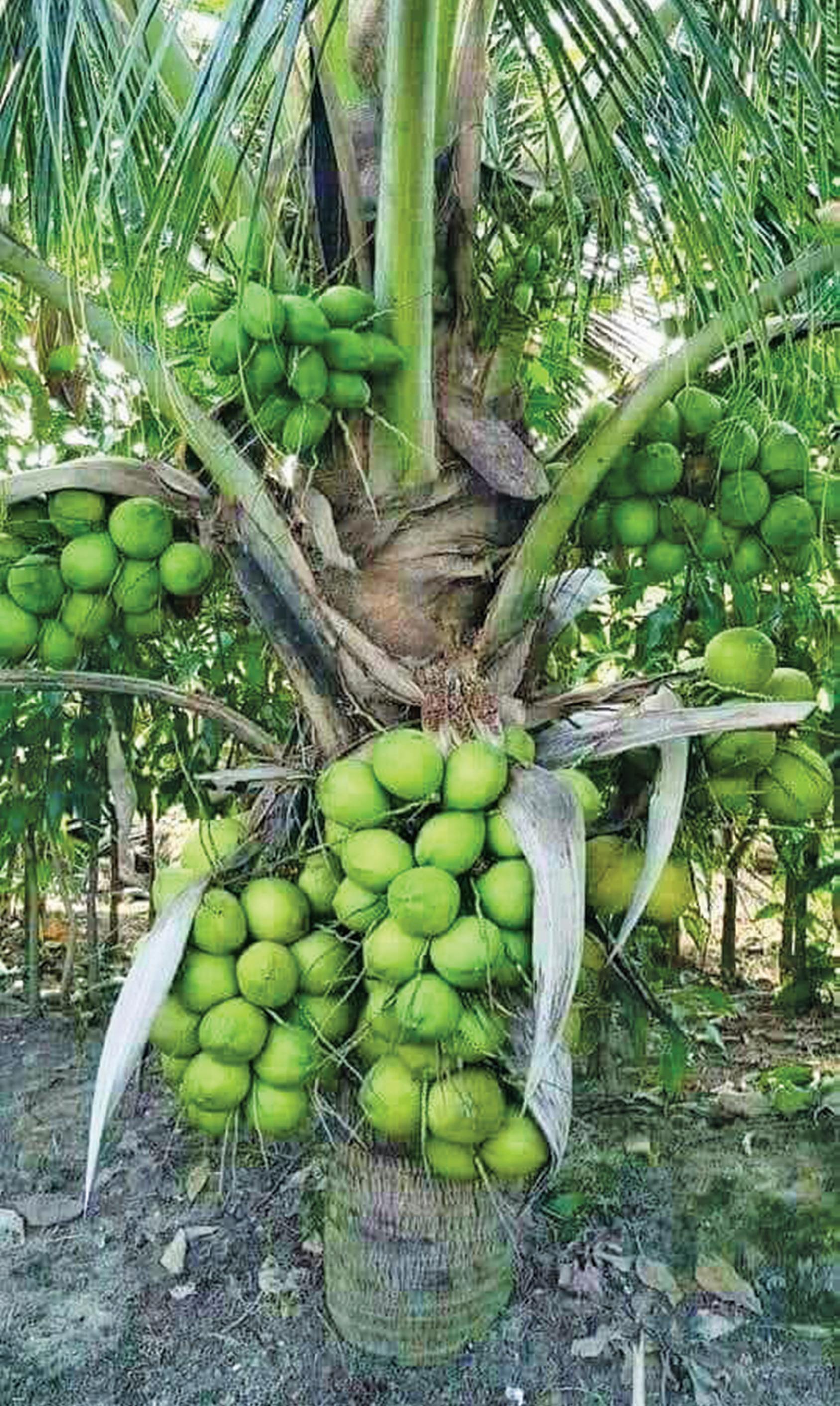
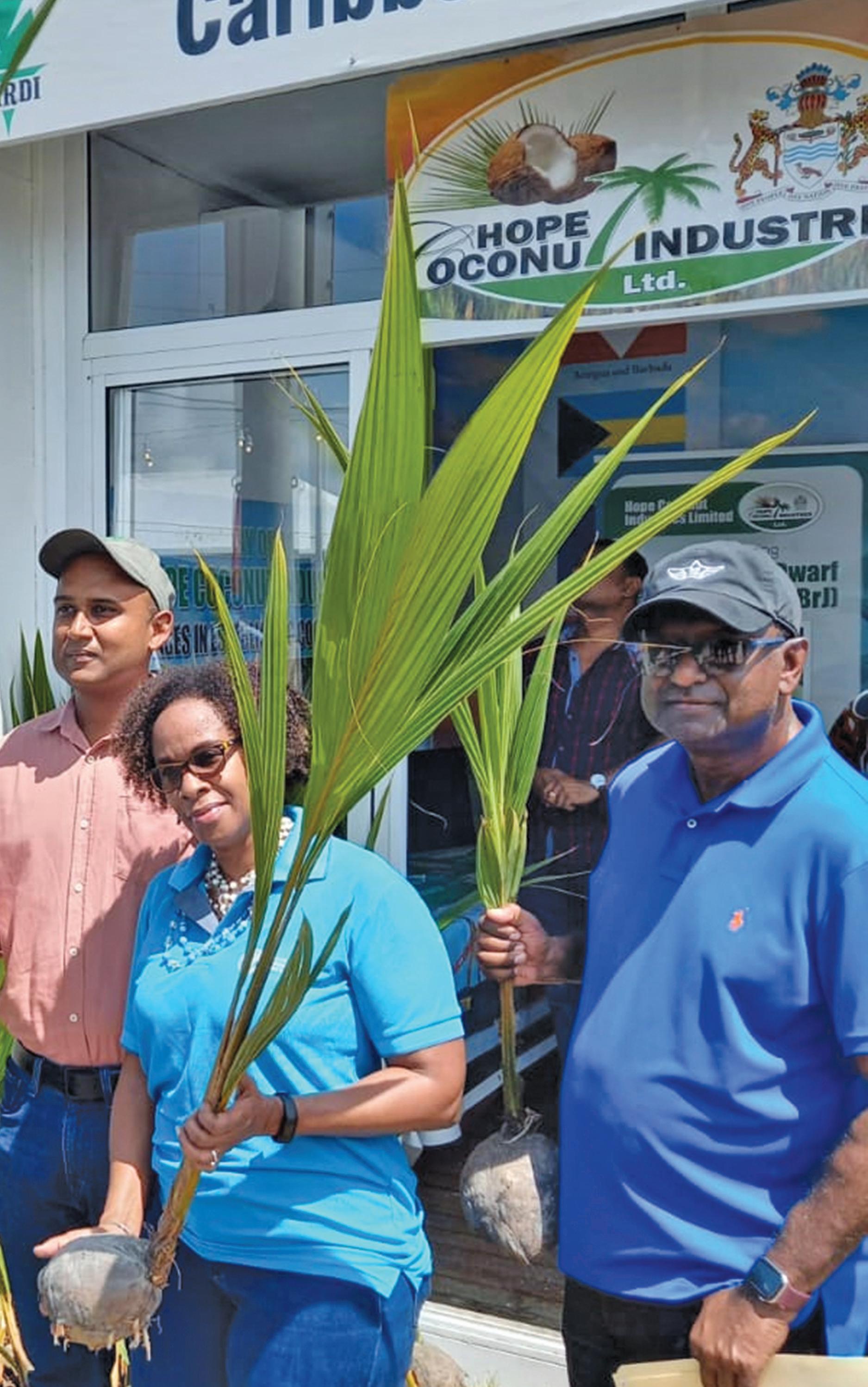
Roopchand said Guy ana is “a little behind when it comes to value-added
products with coconuts, and farmers and producers are shortchanged as a result.”
He also noted that the gov ernment has invested in a coconut fibre machine that would be used to convert the husk into coconut fibre and coconut peat, which is a “wonderful” material for mulching and may be utilised in nurseries due to its high capacity to absorb mois ture. Pomeroon is one such area where the machine will greatly assist the people and the environment after it was revealed that coconut husks were being thrown into the river, posing a serious threat to boat users as well.
There has been a signifi cant increase in the capacity for coconut seedlings. At the end of 2022, Guyana should have its 10th nursery in Let hem, bringing the country’s capacity to produce coconut seedlings to a total of two hundred and six thousand per year compared to the year 2020, where the capacity could have only produced fifteen hundred. The decen tralised programme enables people from Mabaruma, for example, to have easy access to an adequate number of seedlings at an affordable cost without the hassle of transportation.
In terms of coconut acre
age, a conservative target was set to accommodate the expansion of the coconut in dustry for the next five years. Roopchand explained that the idea was to expand 1,000 acres per year, but in 2021, instead of 1,000 acres, the industry expanded by over 2,000 acres. The same 1,000acre target was set for this year, but as of August, it has reached 2,759 acres. “It is a good sign for the industry’s trajectory,” Roopchand said.
According to Roopchand, with oil and gas being on the front burners of Guyana’s economy, the President of Guyana, Dr. Irfaan Ali, along with the Minister of Agricul
ture, has made it clear that the agriculture sector would not be neglected in Guy ana’s future. He praised the Government of Guyana and Minister Mustapha for the “phenomenal” job that they have been doing in the sector.
Roopchand also made special mention that, for the past three years, under the capital programme, Hope Estate has received $82 million from the gov ernment to fix its infra structure on the estate as well as under the decentral isation programme where they serve the needs of the farmers.
Aquaculture sector set for expansion
— as gov’t eyes increase in shrimp, prawn production
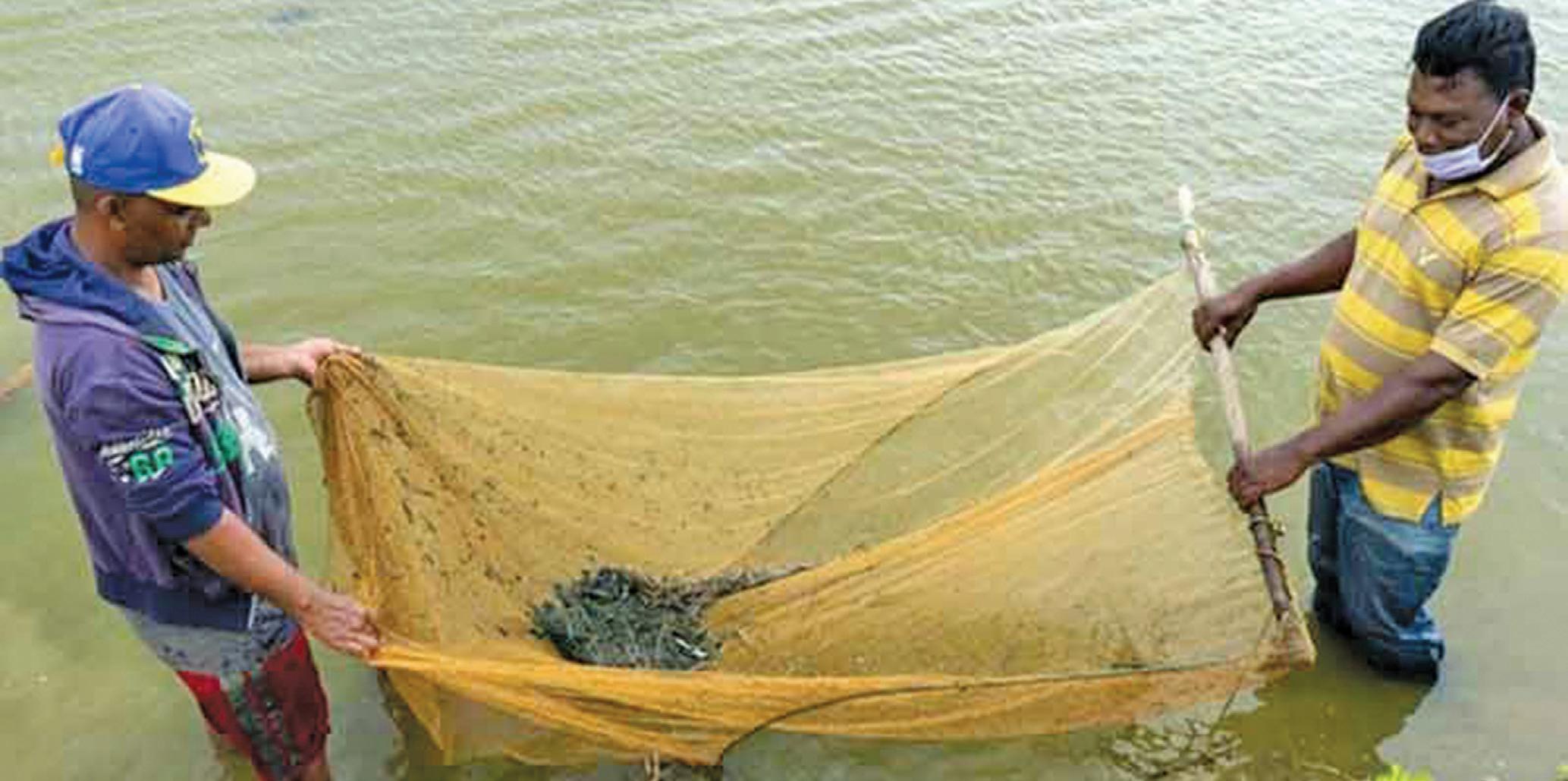
WITH the sum of $142.7 million expended by the Fisheries Department during the first half of 2022, Guyana’s aquacul ture sector is on course for tremendous expan sion.
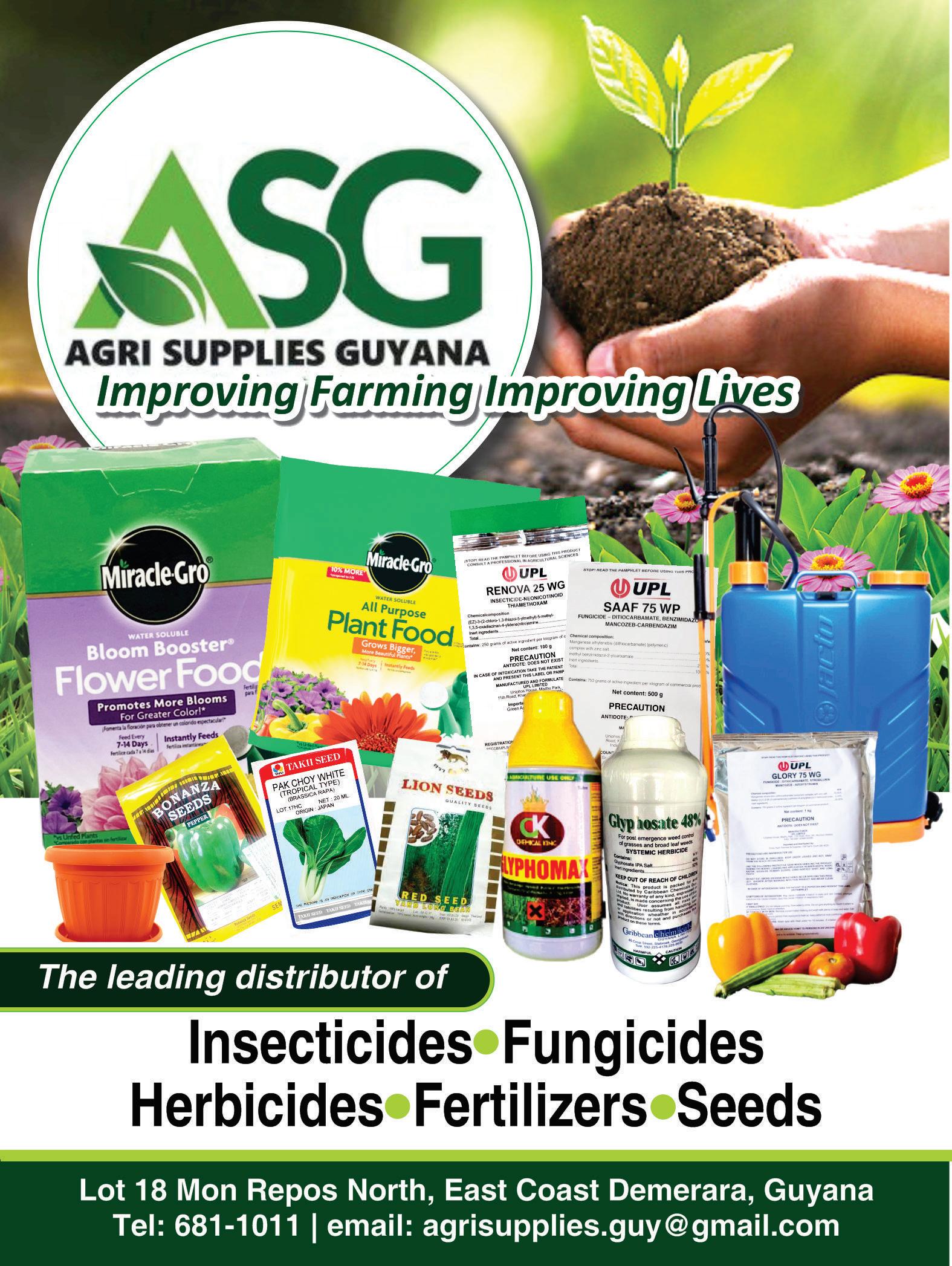
With the introduction of new practices and gov ernment’s intervention, aquaculture production has increased by 444.1 per cent in the first half of the year, with the brack ish water shrimp produc tion increasing by 292.6 per cent.
In a recent interview with the Guyana Chron icle, Agriculture Minis ter, Zulfikar Mustapha, disclosed that, with the expansion of 1,833 acres of ponds in Region Six (East Berbice-Coren tyne), Guyana’s shrimp production has been in creasing rapidly.
“We have seen a num ber of ponds that have al ready been completed. To date, we have completed 1,833 acres of ponds that gave us 89 farms [and] 180 ponds. To date we
are seeing production increasing every month,” Minister Mustapha said.
In 2021, Minister Mu stapha met with various stakeholders at the Al bion Sports Complex, where he stressed that the government was “looking to improve shrimp farm ing in Berbice”.
He announced then that his ministry will be spending $58 million on shrimp ponds in Region Six to boost production.
He also reiterated that the government had been working “assiduously” to ramp up production.
“We are working very hard to complete this project. We are about 80 per cent into completion and I am hoping [that] at the end of it all, we can have 12,000 kilogrammes monthly, and we can get the projected outcome of 1.2 million kilogrammes annually,” the agriculture minister said.
He added: “This is showing very good signs for us and I think that, with the civil works that
we are doing in enhanc ing the ponds and put ting other mechanisms in place, we will see more and more production.”
Some $153 million was earned after the pro duction of approximately 127,400 kilogrammes of shrimp between January and March 2022.
The total showed 81,740 kilogrammes more when compared to the 45,660 kilogrammes of shrimp produced during the same period in 2021, at an estimated value of $40 million.
PRAWNS
Meanwhile, Minis ter Mustapha disclosed that the government will soon begin production of prawns in Berbice.
“While we are do ing the brackish water shrimp, we are also look ing to start prawn produc tion very shortly. We will start in the West Coast Berbice and East Bank Berbice [areas where] two projects will start.”
According to the min
ister, the project which was launched by Pres ident, Dr Irfaan Ali, at the ‘Agri’ Investment Forum and Expo back in May, will target women, youths and former sugar estate workers who were left unemployed after the closure of the sugar es tates in 2017 by the then A Partnership for Nation al Unity + Alliance For Change (APNU+AFC) government.
Additionally, with the collaboration of the Hubu Aqua Farm, Minister Mustapha is optimistic that prawn production will see good results, thus boosting Guyana’s aqua culture prospects.
“We will have our own larvae that will be produced by the farm. So, we won’t have to import it now; we will produce it and within this kind of production we will increase our aquaculture income tremendously,” he added.
An effective climate action must consider food security
— IICA Director-General expects agriculture to be the protagonist at COP
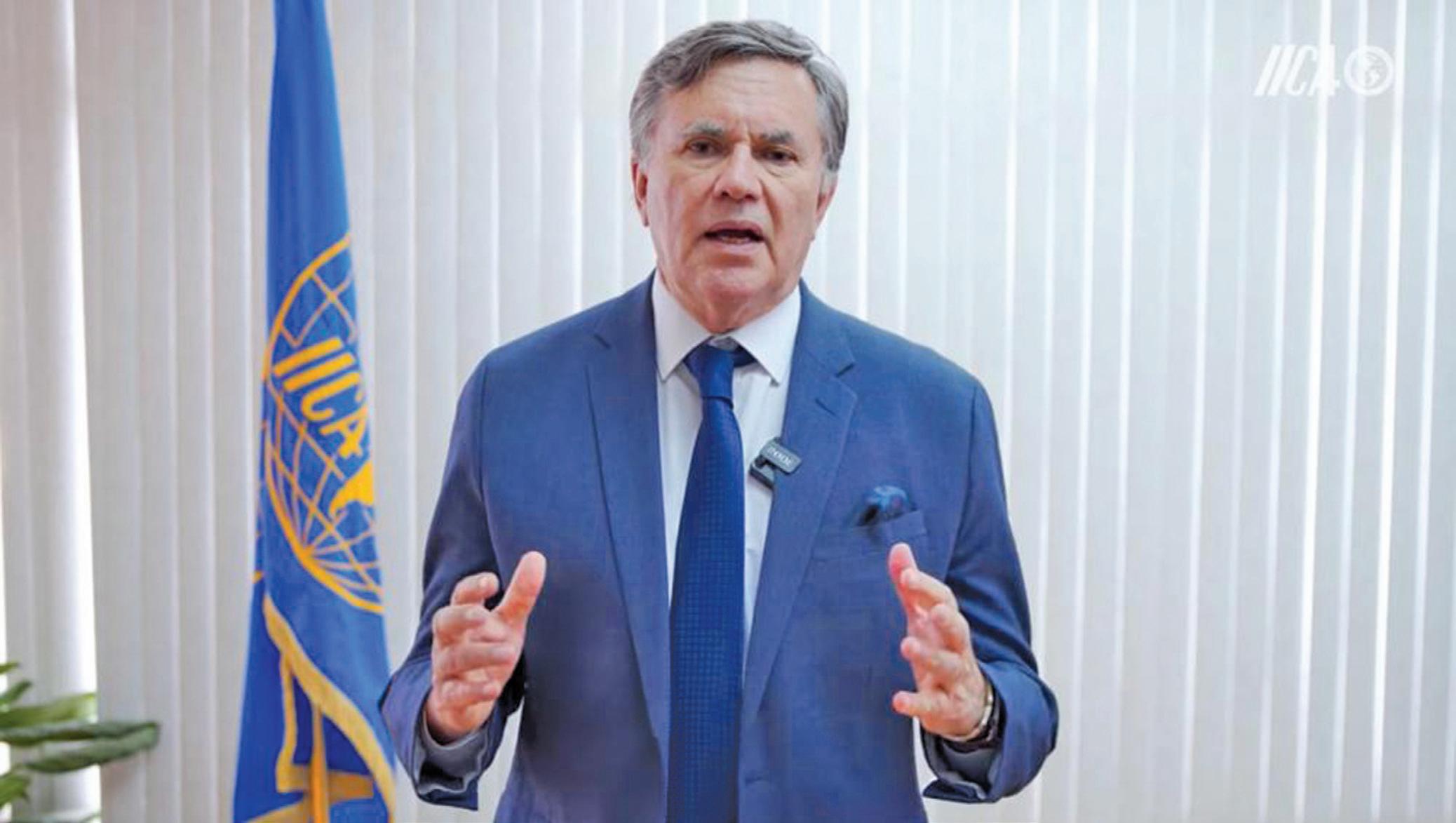
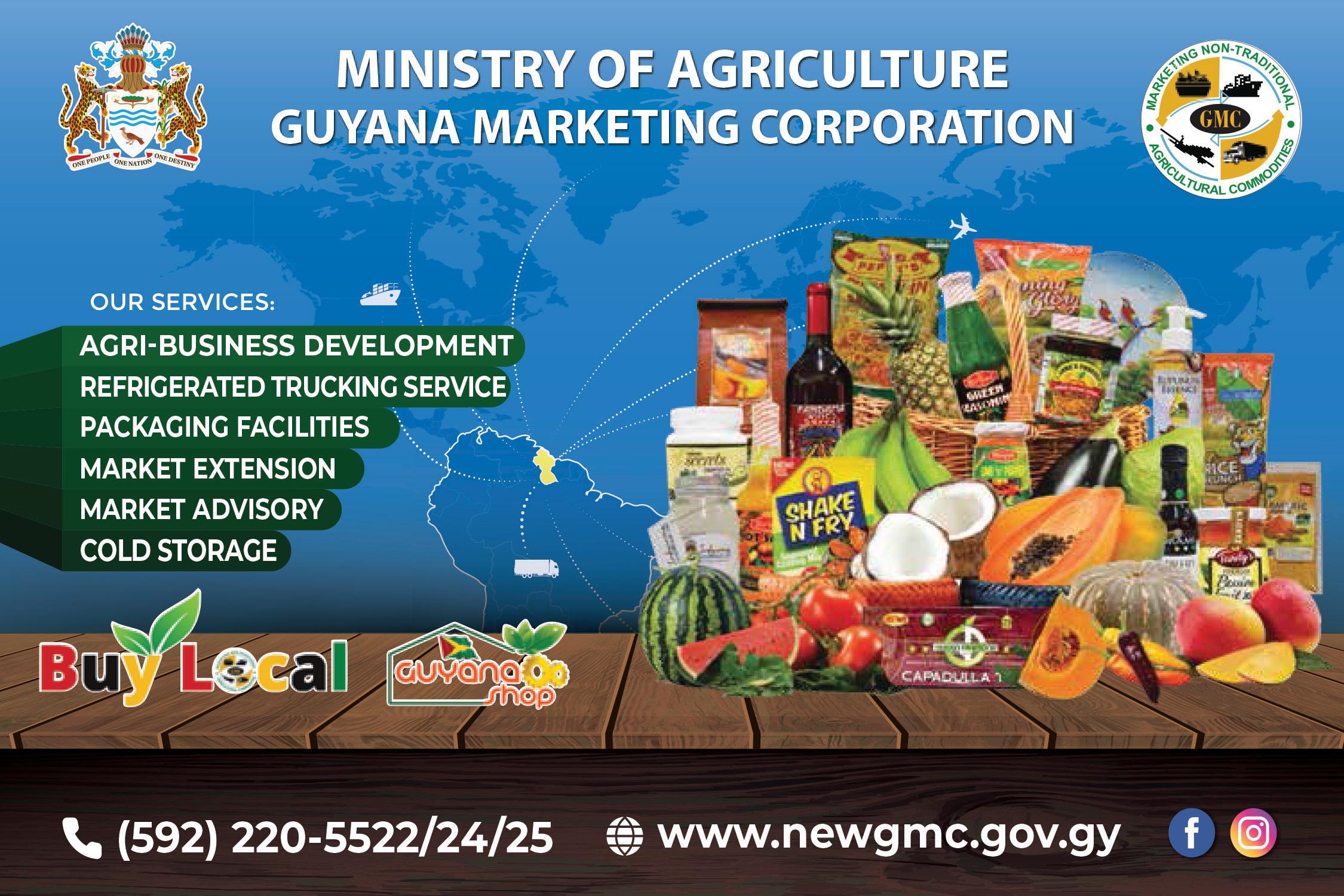
DIRECTOR-General of the Inter-American In stitute for Cooperation on Agriculture (IICA) Manuel Otero stated that the next Conference of the Parties to the Unit ed Nations Framework Convention on Climate Change (COP 27), billed for November 6 in Egypt, must be the COP of agri culture and the COP of ef fective climate action, and insisted that the agricul ture sector must become a strategic pillar and a relevant actor for climate negotiations.
“I have no doubt that this will be the COP of sustainable agriculture; the COP of action, because the
issue of climate change is here, and it is happening now,” said Otero before his participation in the Confer ence that will take place this year in the Egyptian city of Sharm El Sheik.
“The countries that make up IICA are suffering the consequences of cli mate change: Droughts and floods are now common in a scenario dominated by more intense and frequent ex treme weather events. Faced with this, the only option is sustainable agriculture, and we have already embarked in this transition,” affirmed the head of the hemispheric organisation specialising in agriculture and rurality.
Along the foregoing
on page
Fisherfolk: $150K grant could not have come at a better time
THE government’s one-off grant of $150,000 to fish erfolk across Guyana was rolled out in Region Six last month.
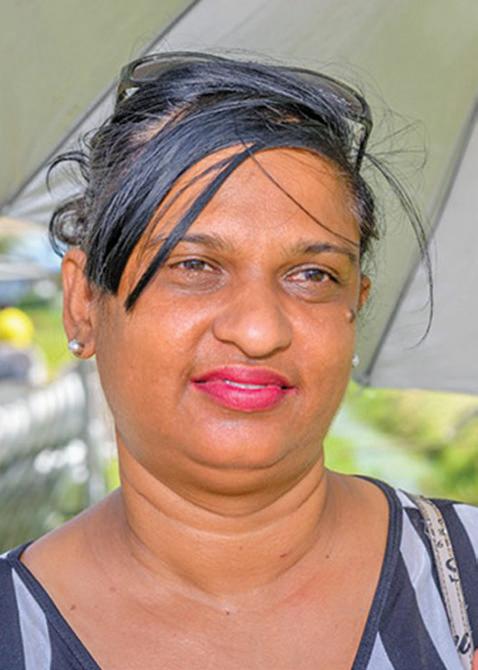
The programme was first announced by President, Dr. Irfaan Ali some four months ago. The extended time to launch the programme was due to systems put in place by the government to ensure greater scrutiny of names submitted as valid benefi ciaries for the grant. More than 5,000 fisherfolk have benefitted from the initiative, which seeks to cushion the impact of the increase in the cost of living. Many fisher folk who received the grant have thanked the government for the timely intervention. The following is what some of them had to say about the initiative:
Reland Roberts told the Guyana Chronicle that the funds will help him effect much-needed repairs to his boat, as well as provide for his household. “We got a lot of things to do; we got chil dren going to school, so the money will come in good. Some of it is going be spent on the boat; the seine and so damage, so I could fix that,” Roberts said.
do much-needed repairs to one of her boats.
“My husband, he goes out in the sea and fish wasn’t catching. Right now, he is at work, and everything is okay for now, because we glad for the little money to repair the boats and everything,” Bibi said.
money is a big help for me,” said Chattergoon, who is still grieving the loss of his wife who died last year.
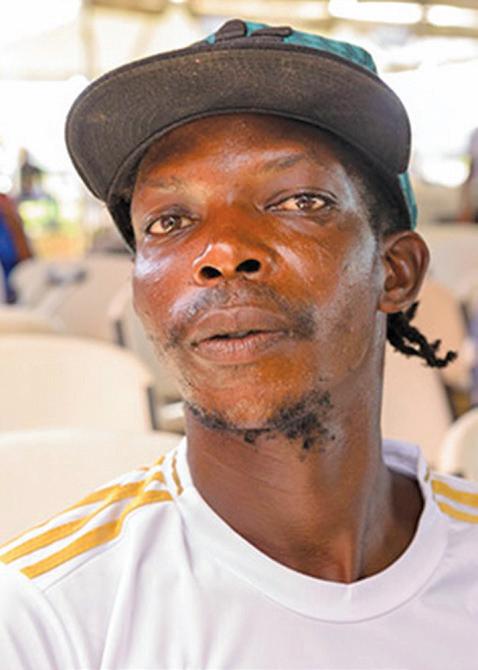
Fitz Calvan, of Charity, Essequibo Coast, told the Guyana Chronicle that he is working towards owning his own boat and employing persons to work with him. He plans to use the money to improve his life.

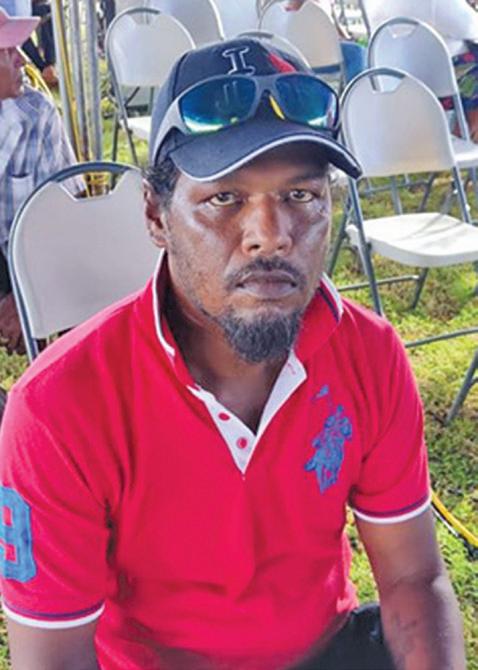

“As a young man, and a father of one,” Fitz said, “I want to own my own boat, and go out to sea. I want to be an entrepreneur and my own boss in the fishing industry.”
An effective climate action must consider...
page
lines, Otero highlighted the efforts made by the regional agricultural sector, under the coordination of IICA, with a focus on tackling a problem that requires effective and immediate action, and for which the hemisphere will be presenting a consoli dated position at the COP.
“The Ministers of Agriculture (of the Americas) have defined a process of co ordination, and have found points in common around a series of guiding principles; this shows that there is a clear link between sustainable agriculture and sustainable development,” he said in reference to the messages that the hemisphere will present as a bloc, which highlight the importance of agriculture as part of the solution in the fight against climate change, and its essential role for food security.
This strong regional consensus was reached by the Ministers and Secretaries of Agriculture of 32 countries of the Americas, and establishes that climate actions to achieve a more sustainable agriculture must be based on science in order to protect and increase productivity and not aggravate the already serious current food crisis.
SUSTAINABLE AGRICULTURAL PRACTICES
Esmond Duke told the Guyana Chronicle that he is thankful for the grant, and plans to put the money to good use.
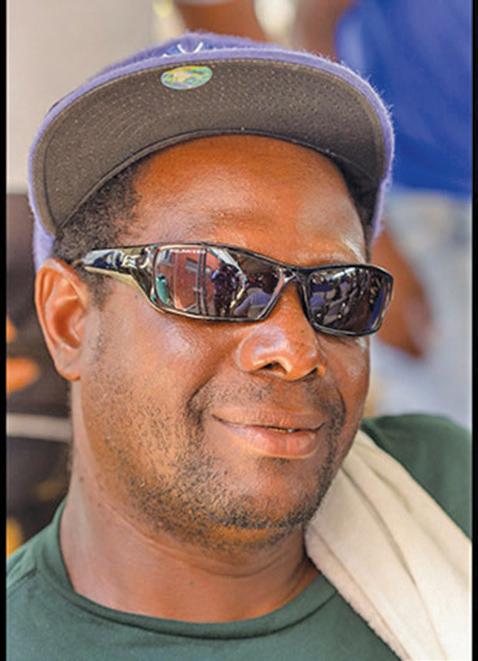
Sanjay Chattergoon, of Number 62 Village, Coren tyne, told the Guyana Chron icle that he had been out of work for the past three weeks after losing a toe while at sea.
Jagdesh Rambat said the grant could not come at a better time. Rambat, who has been a fisherman for 38 years, had recently sustained an injury which left him un able to ply his trade.
“I was doing some main tenance work on a boat, and I had a power saw in my hand, and it slip out my hand… So I end up with the injury,” the man explained. Noting that fisherfolk have recently been facing very difficult times, Rambat said: “We are very much thankful for it, because, at the moment, we are going through a struggle on the sea side.”Bibi Nadiea Jabunauth told the Guyana Chronicle that the funds will help her
“I’m happy; it means a lot to me. I have been out of work. Look, see here,” Sanjay said, pointing to his foot. “I lost my toe while at sea. I’m diabetic; I noticed a numbness, and then swelling, and when I visited the doctor, it was in a bad state, so they had to cut it off. So, right now, I’m recovering, and this
“I got a lot of plans; I want to buy another fishing boat, and put it on the water top,” Duke said, adding that fisherfolk have been reeling from the effects of flooding and climate change, and the support from the government is well appreciated. “Some times you get low catches; sometimes you do not get nothing,” he said, adding: “Sometimes it’s $7,000 for gas, and sometimes you don’t have the gas money, and you barely catch lil bit fish. On the water top, most time you taking blows.”
The Director-General of IICA also underscored that the COP 27 in Egypt, which will take place from November 6 to 18, will be a great opportunity to spread the word on agriculture. The Institute, together with its 34 Member States, farmer organisations from the Americas, the private sector and other regional agricultural actors will be present at the “Home of Sustainable Agriculture in the Americas” pavilion, under the motto “Feeding the world, nurturing the planet”, at the SharmEl-Sheikh Convention Centre.
In this space, nearly 60 high-level political and technical events will take place, and examples of good practices, experiences, and lessons learned in the Americas will be shared. These include direct seeding; the implementation of agrosilvopas toral production systems; the system of rice intensification; better management of natural grasslands; reduction of waste from agricultural chains; among other issues.
“In these 60 sessions, we will address the different topics with a self-critical lens, knowing that agri-food systems have room for improvement, but that they are never failed systems,” added Otero.
“We will be presenting a document entitled ‘Sustainable Agriculture Milestones in the Americas’, which outlines the importance of direct seeding for agriculture, especially in the Pampas region, in the United States and Canada. Additionally, we will discuss the agrosilvopastoral systems in our subtropical areas; the management of natural grasslands; the system of rice intensification in various countries of the Andean and Central American region; the progress made in reducing waste in strate gic chains of Mesoamerica, such as the coffee chain; and the advances in agriculture in the Caribbean. All of these achievements show that there is no turning back in this definitive shift towards sustainable agriculture in the Americas,” he added.
Otero concluded by explaining that similar to the objectives established for the UN Food Systems Summit that took place in September 2021 in New York, the intention of COP 27 is to revalidate three fundamental principles that IICA has promoted in favour of agriculture.
“The farmers are at the centre of all negotiations, as they are the ones who give life, meaning and a notion of the future to our rural areas; science and innovation are the basic input to continue improving performance, and the impact of sectoral policies; and our sector is part of the solution and not of the problem, given the clear and substantive contributions to the mitigation of and adaptation to climate change,” explained the Director-General of the agency specialising in agricultural and rural development of the Inter-Amer ican system. (IICA)
